Kuppan T. Heat Exchanger Design Handbook
Подождите немного. Документ загружается.

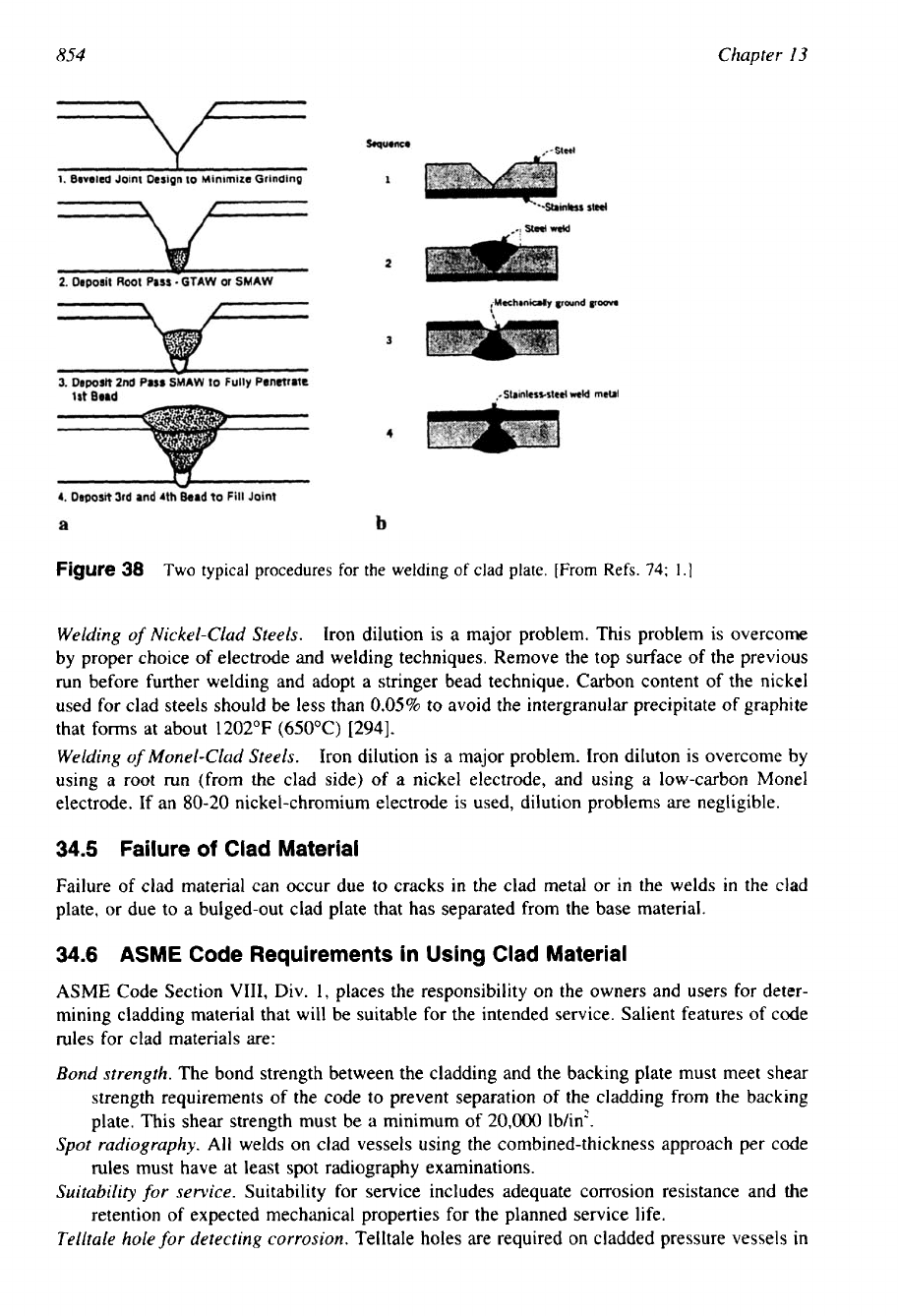
854
Chapter
I3
Figure
38
Two typical procedures for the welding of clad plate. [From Refs.
74;
1.1
Welding
of
Nickel-Clad Steels.
Iron dilution is a major problem. This problem is overcome
by proper choice of electrode and welding techniques. Remove the top surface of the previous
run before further welding and adopt a stringer bead technique. Carbon content of the nickel
used for clad steels should be less than
0.05%
to avoid the intergranular precipitate
of
graphite
that
forms
at about
1202°F
(650°C)
[294].
Welding
of
Monel-Clad Steels.
Iron dilution is a major problem. Iron diluton is overcome by
using a root
run
(from the clad side) of a nickel electrode, and using a low-carbon Monel
electrode. If an
80-20
nickel-chromium electrode is used, dilution problems are negligible.
34.5
Failure
of
Clad Material
Failure of clad material can occur due
to
cracks in the clad metal or in the welds
in
the clad
plate, or due to a bulged-out clad plate that has separated from the base material.
34.6
ASME
Code Requirements in Using Clad Material
ASME Code Section VIII, Div.
1,
places the responsibility on the owners and users for deter-
mining cladding material that will be suitable for the intended service. Salient features of code
rules for clad materials are:
Bond strength.
The bond strength between the cladding and the backing plate must meet shear
strength requirements of the code to prevent separation of the cladding from the backing
plate. This shear strength must be a minimum
of
20,000
lb/in?.
Spot radiography.
All welds on clad vessels using the combined-thickness approach per code
rules must have at least spot radiography examinations.
Suitability for service.
Suitability for service includes adequate corrosion resistance and the
retention of expected mechanical properties for the planned service life.
Telltale hole
for
detecting corrosion.
Telltale holes are required on cladded pressure vessels in
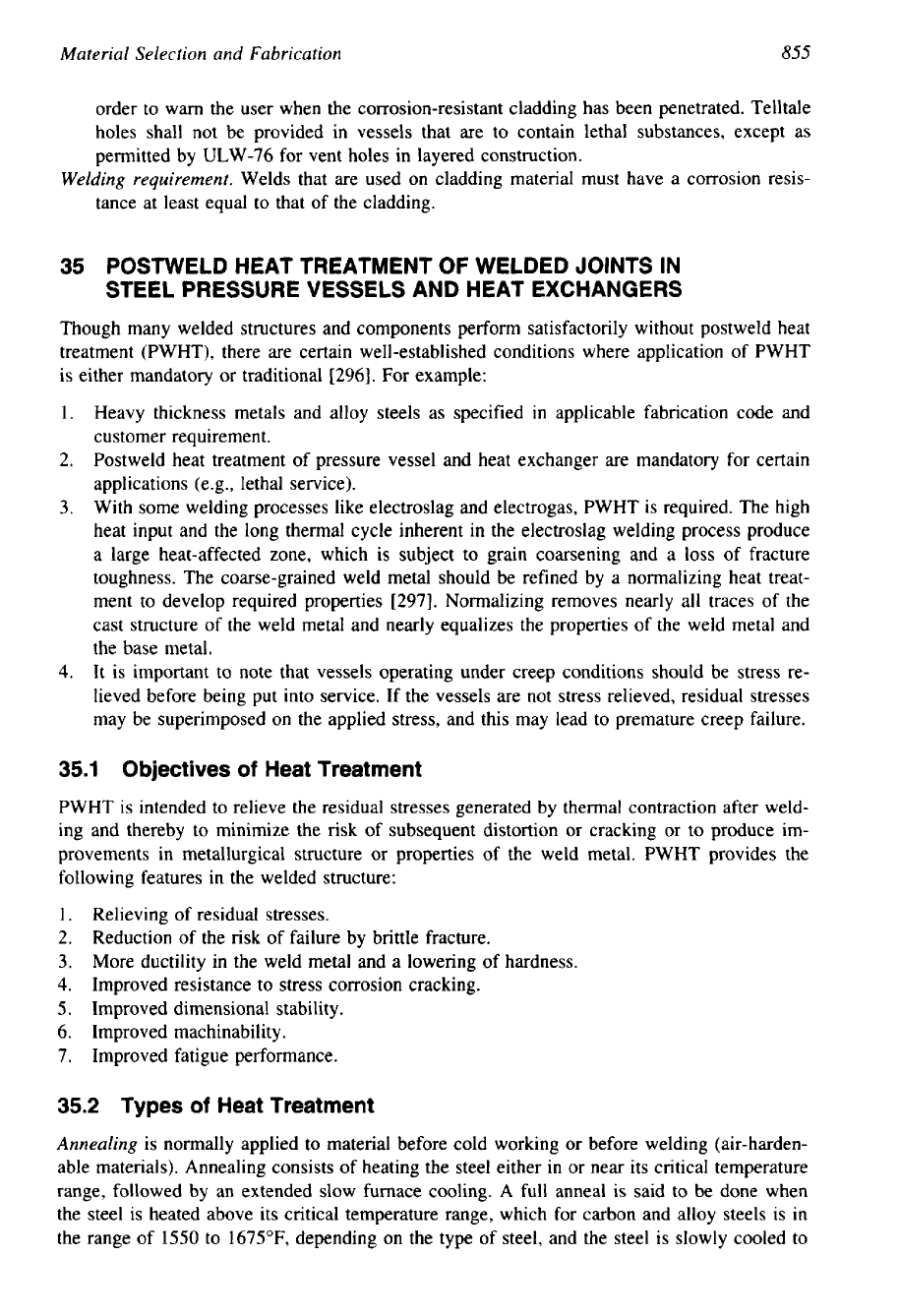
Material Selection and Fabrication
855
order to warn the user when the corrosion-resistant cladding has been penetrated. Telltale
holes shall not be provided in vessels that are to contain lethal substances, except as
permitted by ULW-76 for vent holes in layered construction.
Welding requirement.
Welds that are used on cladding material must have a corrosion resis-
tance at least equal to that of the cladding.
35
POSTWELD HEAT TREATMENT OF WELDED JOINTS
IN
STEEL PRESSURE VESSELS AND HEAT EXCHANGERS
Though many welded structures and components perform satisfactorily without postweld heat
treatment (PWHT), there are certain well-established conditions where application of PWHT
is either mandatory or traditional [296]. For example:
1.
Heavy thickness metals and alloy steels as specified
in
applicable fabrication code and
customer requirement.
2.
Postweld heat treatment of pressure vessel and heat exchanger are mandatory for certain
applications (e.g., lethal service).
3.
With some welding processes like electroslag and electrogas, PWHT is required. The high
heat input and the long thermal cycle inherent in the electroslag welding process produce
a large heat-affected zone, which is subject to grain coarsening and a loss of fracture
toughness. The coarse-grained weld metal should
be
refined by a normalizing heat treat-
ment to develop required properties [297]. Normalizing removes nearly all traces of the
cast structure of the weld metal and nearly equalizes the properties of the weld metal and
the base metal.
4.
It is important to note that vessels operating under creep conditions should be stress re-
lieved before being put into service. If the vessels are not stress relieved, residual stresses
may be superimposed on the applied stress, and this may lead to premature creep failure.
35.1
Objectives
of
Heat Treatment
PWHT is intended to relieve the residual stresses generated
by
thermal contraction after weld-
ing and thereby to minimize the risk of subsequent distortion or cracking or to produce im-
provements in metallurgical structure or properties of the weld metal. PWHT provides the
following features in the welded structure:
1.
Relieving of residual stresses.
2.
Reduction of the risk of failure by brittle fracture.
3.
More ductility in the weld metal and a lowering of hardness.
4.
Improved resistance to stress corrosion cracking.
5.
Improved dimensional stability.
6. Improved machinability
.
7. Improved fatigue performance.
35.2
Types
of
Heat Treatment
Annealing
is normally applied to material before cold working or before welding (air-harden-
able materials). Annealing consists of heating the steel either in or near its critical temperature
range, followed by an extended slow furnace cooling.
A
full anneal is said to be done when
the steel is heated above its critical temperature range, which for carbon and alloy steels is in
the range of
1550
to 1675'F, depending on the type of steel, and the steel is slowly cooled to
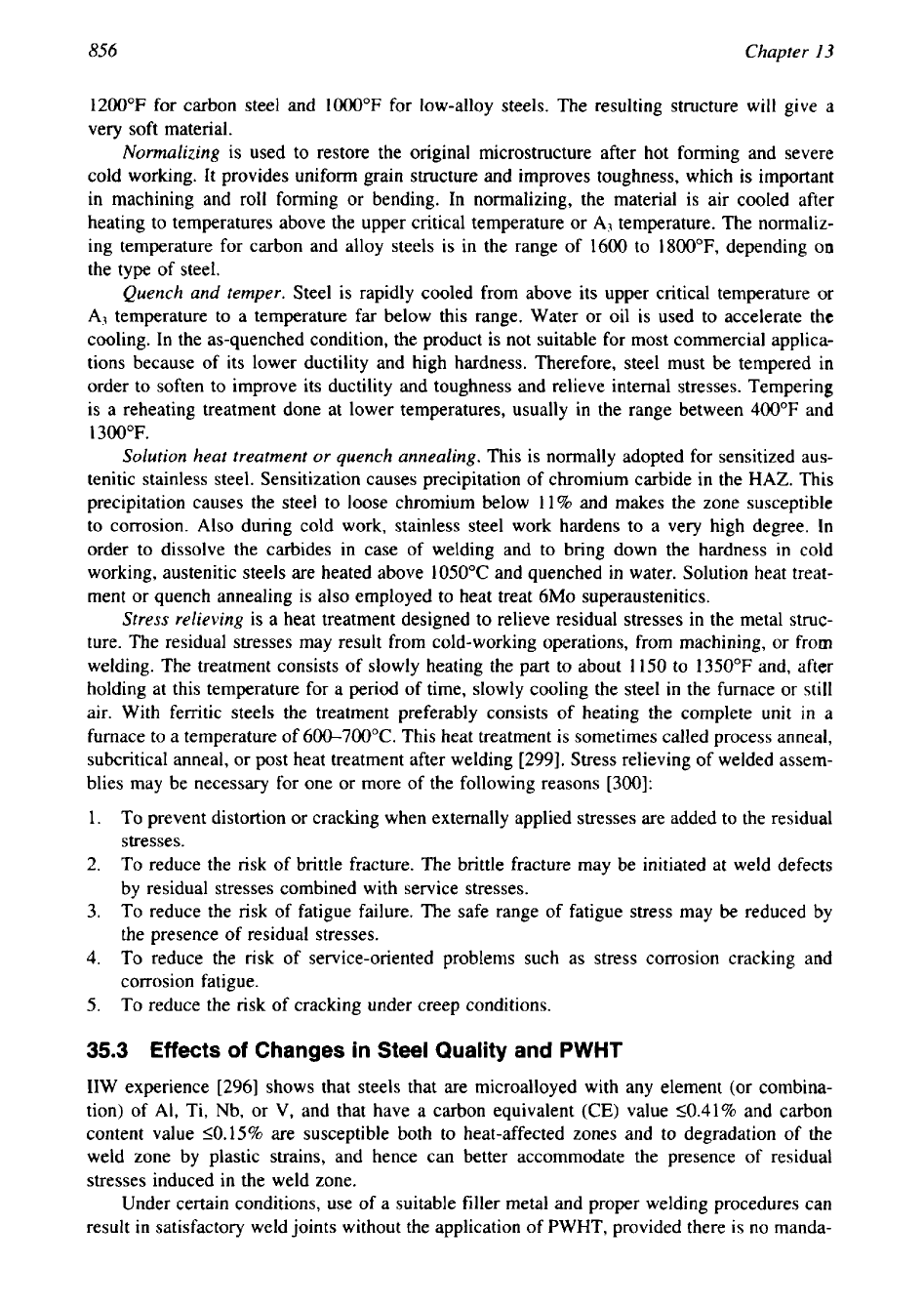
856
Chapter
13
1200°F for carbon steel and 1000°F for low-alloy steels. The resulting structure will give a
very soft material.
Normalizing
is used to restore the original microstructure after hot forming and severe
cold working. It provides uniform grain structure and improves toughness, which is important
in machining and roll forming or bending. In normalizing, the material is air cooled after
heating to temperatures above the upper critical temperature or A3 temperature. The normaliz-
ing temperature for carbon and alloy steels
is
in the range of 1600 to 1800"F, depending
on
the type of steel.
Quench and temper.
Steel is rapidly cooled from above its upper critical temperature
or
A3 temperature to a temperature far below this range. Water or oil is used to accelerate the
cooling. In the as-quenched condition, the product is not suitable for most commercial applica-
tions because of its lower ductility and high hardness. Therefore, steel must be tempered in
order to soften to improve its ductility and toughness and relieve internal stresses. Tempering
is a reheating treatment done at lower temperatures, usually in the range between
400°F
and
1300°F.
Solution heat treatment
or
quench annealing.
This is normally adopted for sensitized aus-
tenitic stainless steel. Sensitization causes precipitation of chromium carbide in the
HAZ.
This
precipitation causes the steel to loose chromium below 11% and makes the zone susceptible
to corrosion. Also during cold work, stainless steel work hardens to a very high degree.
In
order to dissolve the carbides in case of welding and to bring down the hardness in cold
working, austenitic steels are heated above 1050°C and quenched in water. Solution heat treat-
ment or quench annealing is also employed to heat treat 6Mo superaustenitics.
Stress relieving
is a heat treatment designed to relieve residual stresses in the metal struc-
ture. The residual stresses may result from cold-working operations, from machining, or from
welding. The treatment consists of slowly heating the part to about 1150 to
1350°F
and, after
holding at this temperature for a period of time, slowly cooling the steel in the furnace or still
air. With ferritic steels the treatment preferably consists of heating the complete
unit
in
a
furnace to a temperature of 600-700"C. This heat treatment is sometimes called process anneal,
subcritical anneal, or post heat treatment after welding [299]. Stress relieving of welded assem-
blies may be necessary for one or more of the following reasons
[300]:
1. To prevent distortion or cracking when externally applied stresses are added to the residual
stresses.
2.
To
reduce the risk of brittle fracture. The brittle fracture may be initiated at weld defects
by residual stresses combined with service stresses.
3.
To
reduce the risk of fatigue failure. The safe range of fatigue stress may be reduced by
the presence of residual stresses.
4.
To reduce the risk of service-oriented problems such as stress corrosion cracking and
corrosion fatigue.
5.
To reduce the risk of cracking under creep conditions.
35.3
Effects
of
Changes in Steel Quality and PWHT
IIW
experience [296] shows that steels that are microalloyed with any element (or combina-
tion) of Al, Ti, Nb, or
V,
and that have a carbon equivalent (CE) value <0.41% and carbon
content value 10.15% are susceptible both to heat-affected zones and to degradation of the
weld zone by plastic strains, and hence can better accommodate the presence
of
residual
stresses induced in the weld zone.
Under certain conditions, use of a suitable filler metal and proper welding procedures can
result in satisfactory weld joints without the application of PWHT, provided there
is
no manda-

Material Selection and Fabrication
857
tory code requirement for PWHT. If stress-relief treatment is still required, it may be possible
to achieve this with mechanical stress relief or with lower stress relief temperatures than are
usually required.
The carbon content in steel should be lowered to meet the
HAZ
hardness requirements, if
PWHT is not employed
[301].
35.4
ASME
Code Requirements for
PWHT
The requirements for PWHT are dictated by most of the codes as a function of base metal
composition and thickness. The
ASME
Code requires specific heating rates, holding times,
temperatures, and cooling rates.
ASME
Code requirements for PWHT of shell sections, heads,
and other pressure parts were made of carbon and low-alloy steel fabricated by cold forming
are listed in Table
55.
For complete information refer
ASME
Code Section VIII, Div.
1,
UCS-
79
[302].
Charts for Heat Treatment as per
ASME
Code
As
an aid to determining requirements for
PWHT
in accordance with the
ASME
Code, Section
VIII, Divisions
1
and
2,
Carpenter
[303]
developed charts in the form of decision trees. One
Table
55
PWHT
of Carbon and Low-Alloy Steels Vessels ASME UCS-79
1
Contains lethal substance.
2
Least nominal thickness of butt welds in shell and head exceeds 1.5 in.
3
Material over 1.25 through 1.50 in nominal thickness when preheat
is
not ap-
plied at a minimum temperature of 200°F during welding (Table UCS-56).
4
Material requires impact testing
(UCS-66).
5
Carbon and alloy steel fabricated by cold-forming (UCS-56) when the resulting
extreme fiber elongation is more than 5% from the
as
rolled condition and any
one of the following condition exists:
Thickness of the part before cold forming exceeds 0.625 in.
The reduction by cold forming from the as rolled shell or head thickness is
more than
10%.
Temperature of the material during forming is in the range of 250°F
to
900°F.
For P.
No.
1 Groups 1 and
2
materials the extreme fiber elongation may be
as great as
40%
when none of the condtions as
1,
4,
and
5
exist.
Computation of extreme fiber elongation:
i. Double curvature (for example, head):
Percent extreme fiber elongation
=
ii. For single curvature (for example, cylinder);
Percent extreme fiber elongation
=
where
t
is the thickness of plate (in),
Rf
the final center-line radius
(in), and
R,
the original center-line radius (infinity for flat plates).
Conclusion;
a. As per code
PWHT
Reqd/Not Reqd.
b.
As per customer’s requirement Reqd/Not Reqd.
Note.
Refer to code section for more details
and
special conditions.
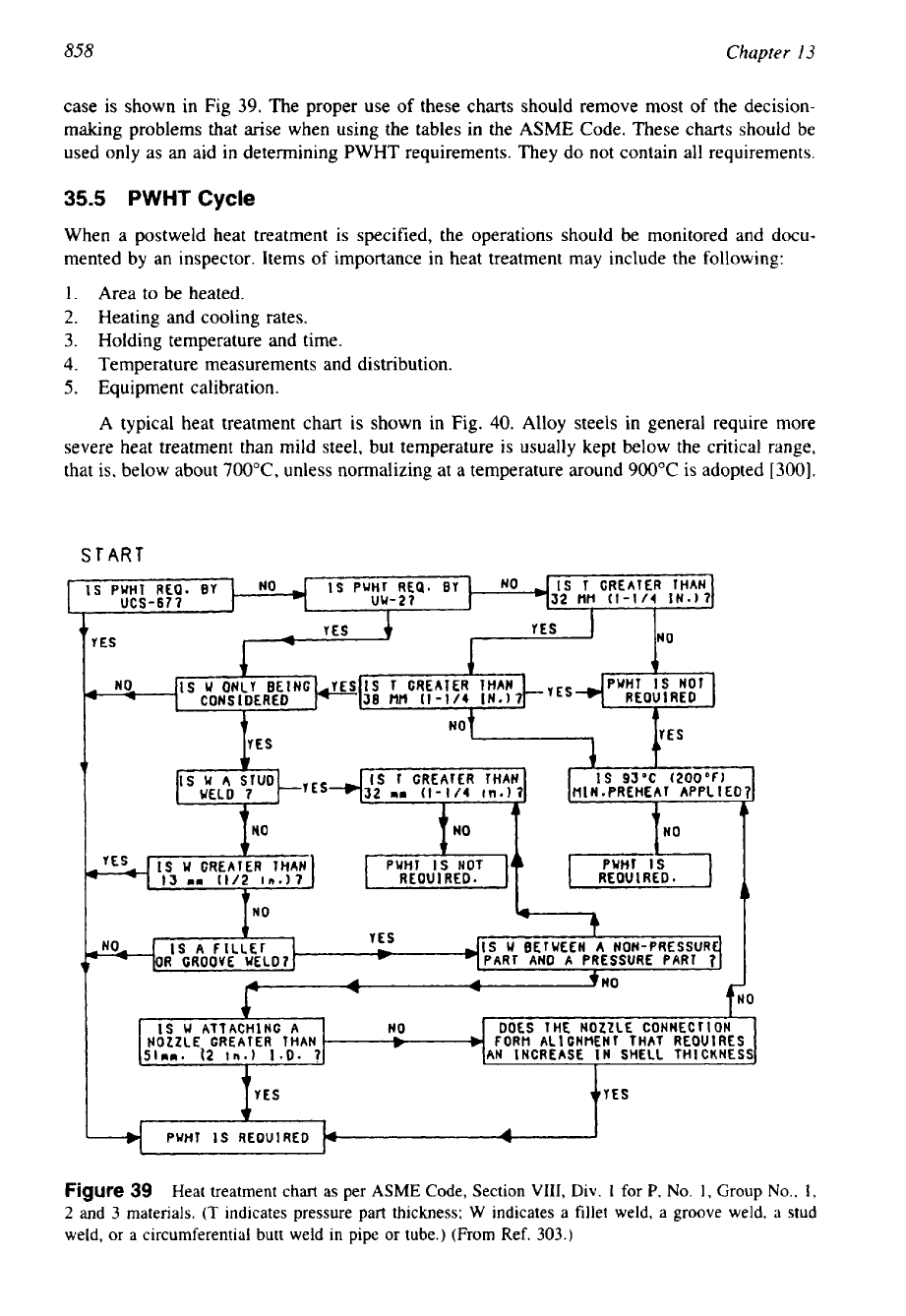
858
Chapter
I3
case is shown in Fig
39.
The proper use
of
these charts should remove most
of
the decision-
making problems that arise when using the tables in the ASME Code. These charts should be
used only as
an
aid in determining PWHT requirements. They do not contain all requirements.
35.5
PWHT
Cycle
When a postweld heat treatment is specified, the operations should be monitored and docu-
mented by an inspector. Items of importance in heat treatment may include the following:
1.
Area to be heated.
2.
Heating and cooling rates.
3.
Holding temperature and time.
4. Temperature measurements and distribution.
5.
Equipment calibration.
A
typical heat treatment chart
is
shown in Fig.
40.
Alloy steels in general require more
severe heat treatment than mild steel, but temperature is usually kept below the critical range,
that is, below about
7OO0C,
unless normalizing at a temperature around
900°C
is adopted
[300].
START
IS
93'C
(200°F)
IS
W
ATTACHING
A
NO
DOES
THE
NOZZLE CONNECTION
NOZZLE GREATER THAN
-
r
+
FORM
ALICNHENT
THAT
REOUIRES
SInn.
t2
In.)
1.0.
7
AN INCREASE IN
SHELL
THICKNESS,
YES
A
w
Figure
39
Heat treatment chart as per ASME Code, Section
VIII,
Div.
1
for
P,
No.
1,
Group
No.,
1,
2
and
3
materials.
(T
indicates pressure part thickness;
W
indicates a fillet weld, a groove weld,
a
stud
weld,
or
a circumferential butt weld in pipe or tube.) (From Ref.
303.)
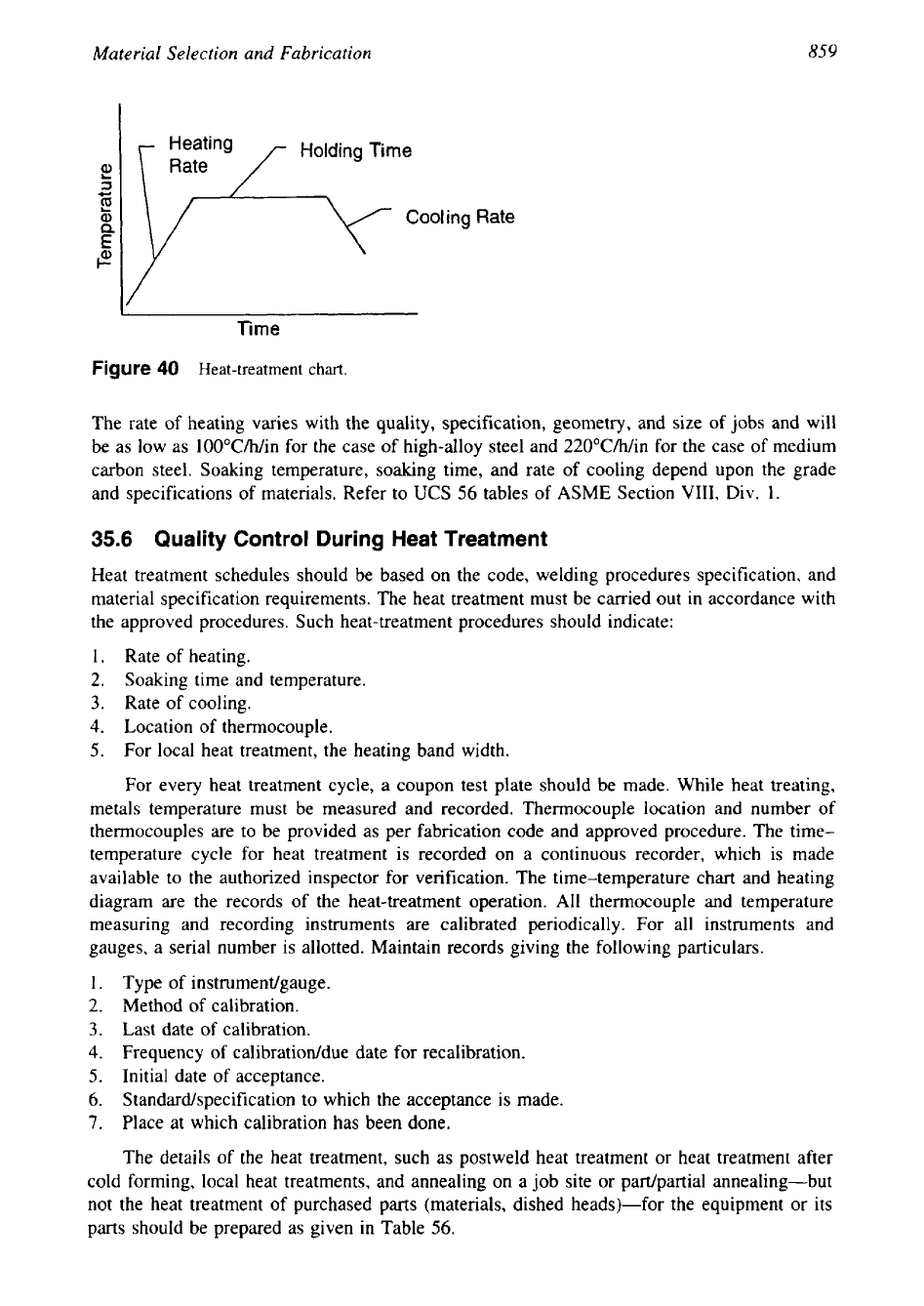
859
Material Selection and Fabrication
Time
Figure
40
Heat-treatment
chart.
The rate of heating varies with the quality, specification, geometry, and size of jobs and will
be as low as 100"C/h/in for the case of high-alloy steel and 220"C/h/in for the case of medium
carbon steel. Soaking temperature, soaking time, and rate of cooling depend upon the grade
and specifications
of
materials. Refer to
UCS
56
tables
of
ASME
Section VIII, Div.
1.
35.6
Quality Control During Heat Treatment
Heat treatment schedules should be based on the code, welding procedures specification, and
material specification requirements. The heat treatment must be carried out in accordance with
the approved procedures. Such heat-treatment procedures should indicate:
1.
Rate of heating.
2. Soaking time and temperature.
3.
Rate of cooling.
4.
Location of thermocouple.
5.
For local heat treatment, the heating band width.
For every heat treatment cycle, a coupon test plate should be made. While heat treating,
metals temperature must be measured and recorded. Thermocouple location and number
of
thermocouples are to be provided as per fabrication code and approved procedure. The time-
temperature cycle for heat treatment is recorded on a continuous recorder, which is made
available to the authorized inspector for verification. The time-temperature chart and heating
diagram are the records of the heat-treatment operation. All thermocouple and temperature
measuring and recording instruments are calibrated periodically. For all instruments and
gauges, a serial number is allotted. Maintain records giving the following particulars.
1. Type of instrumentlgauge.
2.
Method of calibration.
3.
Last date of calibration.
4.
Frequency of calibratioddue date for recalibration.
5.
Initial date of acceptance.
6.
Standardhpecification to which the acceptance is made.
7.
Place at which calibration has been done.
The details
of
the heat treatment, such as postweld heat treatment or heat treatment after
cold forming, local heat treatments, and annealing on
a
job site or part/partial annealing-but
not the heat treatment of purchased parts (materials, dished heads)-for the equipment or its
parts should be prepared as given in Table
56.
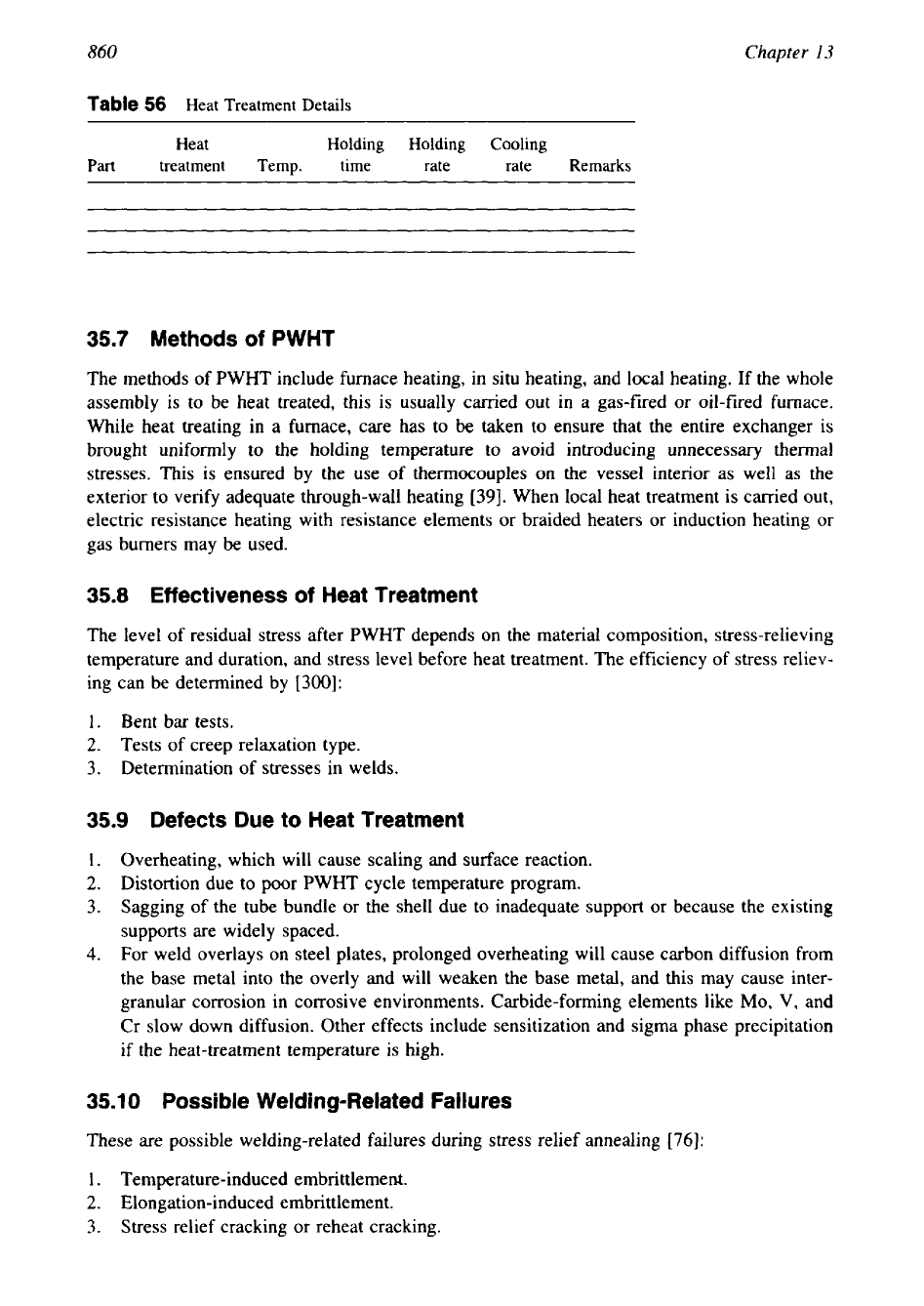
860
Chapter
13
Table
56
Heat Treatment Details
Heat Holding Holding Cooling
Part
treatment Temp. time rate rate Remarks
35.7
Methods of PWHT
The methods of PWHT include furnace heating, in situ heating, and local heating. If the whole
assembly is to be heat treated, this is usually carried out in a gas-fired or oil-fired furnace.
While heat treating in a furnace, care has to be taken to ensure that the entire exchanger is
brought uniformly to the holding temperature to avoid introducing unnecessary thermal
stresses. This is ensured by the use of thermocouples on the vessel interior as well as the
exterior to verify adequate through-wall heating
[39].
When local heat treatment is carried out,
electric resistance heating with resistance elements or braided heaters or induction heating or
gas burners may be used.
35.8
Effectiveness
of
Heat Treatment
The level of residual stress after
PWHT
depends on the material composition, stress-relieving
temperature and duration, and stress level before heat treatment. The efficiency of stress reliev-
ing can be determined by
[300]:
1.
Bent bar tests.
2.
Tests of creep relaxation type.
3.
Determination of stresses in welds.
35.9
Defects Due to Heat Treatment
1.
Overheating, which will cause scaling and surface reaction.
2.
Distortion due to poor PWHT cycle temperature program.
3.
Sagging of the tube bundle or the shell due to inadequate support or because the existing
supports are widely spaced.
4.
For weld overlays on steel plates, prolonged overheating will cause carbon diffusion from
the base metal into the overly and will weaken the base metal, and this may cause inter-
granular corrosion in corrosive environments. Carbide-forming elements like
MO,
V,
and
Cr slow down diffusion. Other effects include sensitization and sigma phase precipitation
if the heat-treatment temperature is high.
35.1
0
Possible
Welding-Related Failures
These are possible welding-related failures during stress relief annealing
[76]:
1.
Temperature-induced embrittlement.
2.
Elongation-induced embrittlement.
3.
Stress relief cracking or reheat cracking.

861
Material Selection and Fabrication
35.11
NDT
After
PWHT
Certain materials are prone to cracking during PWHT. This is known as reheat cracking
or
stress relief cracking. Heat-affected
zones
of welds of such materials are to be subjected to
NDT after PWHT. The materials susceptible to reheat cracking and susceptible materials were
discussed with weldability problems in the section on material selection and the section on
weldability problems.
This page intentionally left blank
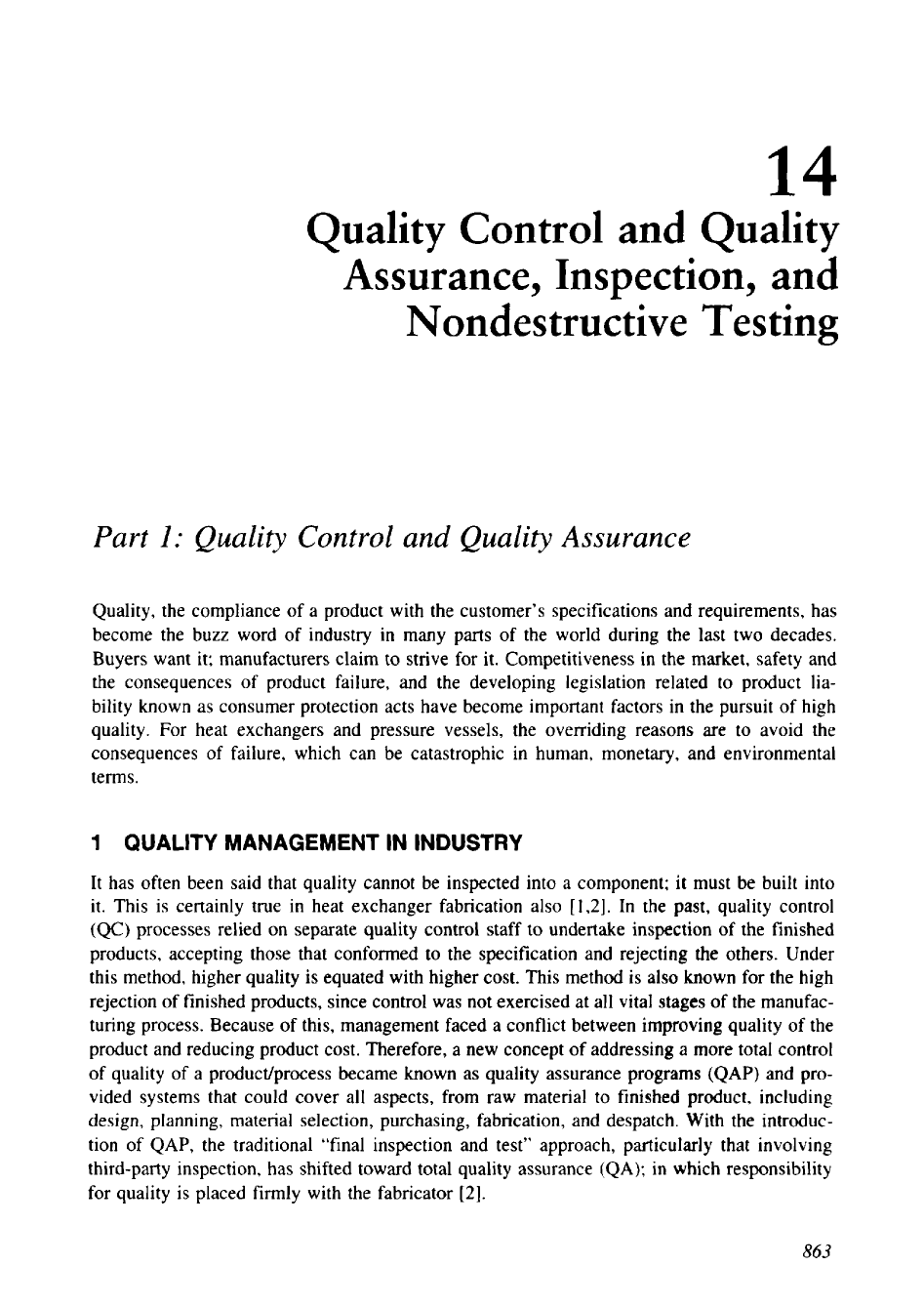
14
Quality Control and Quality
Assurance, Inspection, and
Nondestructive Testing
Part
I:
Quality Control and Quality Assurance
Quality, the compliance of a product with the customer’s specifications and requirements, has
become the buzz word of industry in many parts of the world during the last two decades.
Buyers want it; manufacturers claim to strive for it. Competitiveness in the market, safety and
the consequences of product failure, and the developing legislation related to product lia-
bility known as consumer protection acts have become important factors
in
the pursuit of high
quality. For heat exchangers and pressure vessels, the overriding reasons are to avoid the
consequences
of
failure, which can be catastrophic in human, monetary, and environmental
terms.
1
QUALITY MANAGEMENT
IN
INDUSTRY
It has often been said that quality cannot be inspected into a component; it must be built into
it. This is certainly true in heat exchanger fabrication also
[1,2].
In the past, quality control
(QC)
processes relied on separate quality control staff to undertake inspection of the finished
products, accepting those that conformed to the specification and rejecting the others. Under
this method, higher quality is equated with higher cost. This method is also known for the high
rejection of finished products, since control was not exercised at all vital stages of the manufac-
turing process. Because of this, management faced a conflict between
improving
quality of the
product and reducing product cost. Therefore, a new concept of addressing a more total control
of quality of a product/process became known as quality assurance programs
(QAP)
and pro-
vided systems that could cover all aspects, from raw material to finished product, including
design, planning, material selection, purchasing, fabrication, and despatch. With the introduc-
tion of QAP, the traditional “final inspection and test” approach, particularly that involving
third-party inspection, has shifted toward total quality assurance (QA); in which responsibility
for quality is placed firmly with the fabricator
[2].
863
